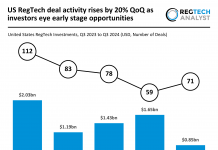As technology continues to evolve over the long-term, one particular trend we can expect to remain is that of the role of voice – especially within the field of communications compliance. As we look towards the future, how can this technology bring change to the financial industry?
The role of technology is ever-increasing within the daily practices of companies, particularly in the financial space. Many firms are also moving to the cloud. What could this mean for the role of voice and voice calling?
In the view of Susannah Hammond, senior regulatory intelligence expert at Theta Lake, there is a huge drive to move to the cloud, with a wide plethora of unified communication and collaboration tools coming to the fore. They are, in her opinion, the next technological revolution that is making the business lives of people more effective and efficient.
“They are also device-agnostic and location-agnostic, and they give you so much more inherent flexibility if you adopt voice in the cloud,” said Hammond. She added that users also get not only functionality and simplicity, but also scalability and ‘profound cost-efficiency’. If companies are going to adopt all of these, she stated they have got to have the back-end compliance tool to take advantage of it and store and capture all of these voice calls compliantly.
For financial services firms, the need for such technology is statutory, and is not an optional extra. Hammond explains that for companies that have legacy compliance infrastructure, and have complex, patchwork systems, they may need a rethink on their technology. “Many of these don’t lift and drop into the cloud – you’re going to have to have a modern technology that is future-proof and is able to see what is coming,” she said.
“Voice going into the cloud with unified communications doesn’t exist in a vacuum,” said Hammond. “It’s meshed together with SMS, visual – everything comes together as a hybrid package. Whichever system you choose has got to be able to deal with the fact that voice is no longer a standalone thing. As part of a UCC, it becomes an incredibly powerful, integrated means of communication. But you’ve got to have the right infrastructure to support all of that.”
Moving to the cloud
The desire on the part of companies across the financial industry to move their devices to cloud is not merely driven interest – it is driven by necessity, as cloud usage becomes vital. However, challenges surround the technology.
Coming from a financial services perspective, Hammond outlined the recent challenges around fines in the industry. “We’re looking at the best part of $3bn in fines – and this is just the tip of the iceberg when it comes to areas such as lack of compliance and sanctions.
“Furthermore, in the US specifically, regulators have reached zero-tolerance. They’re not standing for any more fines in this area. So, if you don’t make steps towards being compliant and getting this right, firms are going to be in a lot of trouble. They simply cannot afford to get this wrong.”
Hammond outlined that firms have a huge technological opportunity to transform their business, but it has to be done in the right way – enter digital communications governance. In the view of Hammond, firms must have a digital communications governance strategy that covers all the meshed areas such as text, image, video and more which come together.
She said, “You’ve got to be able to deal with the challenges of that package, you’ve got to deal with it as a future-proofed piece of technology. Voice is just one part of that, and putting voice into the cloud enables that integration much more easily. Understanding your regulatory environment is also key. The rules on capture and retention of messaging and text have been there for a while, but because it isn’t a new technological environment, firms have had a collective blind spot in this area. You’ve simply got to be able to comply with the recordkeeping requirements, it doesn’t matter what technology you’re using to do your business.”
Good practices
When it comes to using voice in the cloud, what does good or better practice begin to look like?
In this area, Hammond emphasised three key elements. “Firstly, you’ve got to be able to capture robustly and reconcile it; to know you’ve got everything – and then make sure the retention you’ve got it appropriately meshed into all of the other related unified communications content. You can’t have gaps.”
Following this, the regulatory expert stressed the importance of being clear about all the privacy and security elements. “Do you know what’s there? Have you got secure storage that keeps all of that protected and safe? Do you have the capacity to redact data? You’ve got to be able to delete appropriate records if requested.
“Equally, if there is a legal situation, you need to be able to weed out the particular voice records and put them safely out of your normal record retention period. You’ve got to be able to do the data governance and search across all modalities, not just voice – this is where legacy voice archiving, often capturing data in a silo doesn’t fit today’s cloud centric workplace. Last but not least, you’ve got to be able to supervise – and you can’t supervise what you haven’t captured. So you’ve got to have that robust capture upfront. You’ve got to have the capacity and capability to flag the risks, you’ve got to be able to see potential violations – that’s where Theta Lake can help,” said Hammond.
Theta Lake has the most compliance integrations for text, voice, virtual meetings and collaboration platforms, as well as being able to record, capture, transcribe, translate, analyse, redact, archive and supervise voice, audio and visual platforms – something Hammond claims firms must have holistically as part of their digital communications governance.
“Getting your recordkeeping right means you have line-of-sight to the management information that means you can run your business efficiently and effectively,” explains Hammond. “Because if you can capture things and you can see what is going on, it is a huge business benefit. It is a challenge going into the cloud, but the benefits if you get it right are transformative.
Voice supervision considerations
When it comes to supervising voice in the cloud, there are a number of considerations to factor in.
Firstly, Hammond underlines the vital importance of ‘native, robust and complete’ capture. But in the area of voice – something that Theta Lake has new patents on – is the focus on transcription, something which she claims is a real ‘foundational’ technology for enabling compliance to be robust, visible and evidenced.
She added, “If you have the right transcription capabilities, this is the next level in terms of the ability of transcription AI – so that even if you had a bad connection the flow of the conversation can still be captured accurately, and when you’ve got that, that can be used for the detection. Critical in all of this is the sheer volume of voice that will be out there – even if you have a small firm, there will be hundreds of hours of voice recordings. If you’re a financial services firm, there will be so much volume that you definitely need the AI, detection and transcription to help you deal with that, as there is no way you can manually review all that.”
In this area, Hammond explained that the great part of Theta Lake’s approach to this is not only does it point out a particular point in a conversation that needs a review, there is also an audit trail that is associated with that. “You’ve not only got assurance that you’ve looked at the right thing in terms of your risk management, but you can evidence that – and I can’t tell you how valuable that is when you talk to a regulator that you can explain why you have looked at that particular point and not the entire recording – and it’s a real sanity check for supervisors because they have confidence they’re looking at the right things and they have line-of-sight to the right things in terms of risk management.”
Another key consideration around supervision is supervising sensitive information correctly. In this respect, Hammond outlined an example of needing to redact or delete personal information including credit card numbers and identify anything unduly personally identifiable and then do something about it. Again, this is an area that has an audit trail around it – which will aid in the identifying of the credit card number to be redacted – something which Hammond explains Theta Lake can help with.
“It’s all very well knowing what the rules are, but how do you apply them in practice, consistently, robustly, and with evidence that you’ve done the right things in the right way,” said Hammond.
The final step in regard to supervision, Hammond outlines, is understanding the insight it gives you to what is going on at the sharp end. “Where you’re going to get the evidence that you’ve done the right things in the right way, voice is a really good place for that to be evidenced.
“Equally, the flipside is if there are policy violations going on, or risky behaviours, those can also be detected there. In some circumstances, it could be a serious policy violation – because it is the context around what is the voice and how it’s being used. With our new solutions that we have, they give you the ability to have that context and that insight, which are invaluable,” said Hammond.
Matching capabilities
One of the big challenges often for compliance functions within the financial industry is ensuring both the front-end and the back end are working in lockstep with each other.
On this point, Hammond explained, “It’s the old conundrum for compliance functions, that the front office got the kit and then the back office was struggling to keep up with how they sorted it out, monitored it, compliance and all the rest of it. The two must be in lockstep with each other.
“You’re going to have a lot of firms moving this way. After all, with voice going to the cloud, you have got to have the back-office functionality to be able to maximise the use of that. The last thing you want is to move the voice to the cloud and you haven’t got the ability or capability of being compliant. If you don’t have the features and functionalities of your new tools switched on, how are people going to communicate effectively?
Hammond encouraged firms to deploy ‘cutting-edge’ compliance solutions like Theta Lake, as when you’ve got both the front-office and back-office solutions working together, you’ve got the best of both worlds.
She continued, “With a modern compliance solution like Theta Lake, you will be able to capture everything. So voice as an integrated, meshed part of all of the other features and functionality. Equally, you will then be able to supervise and comply with the privacy and security concerns and redact and delete, if that is what you need to do – it really does need to be seen as a complete package. You could do one without the other, but I suggest that is a risky way to do your business – you need the compliance solution.”
Hammond also once again took the time to explain the importance of capture, remarking how important it is to capture, retain, reconcile and how you can do them all at scale with Theta Lake.
She said, “The legacy infrastructures were great in their day, but life has moved on – really quite profoundly in terms of the functionality and the capability, so I wouldn’t suggest trying to do a piecemeal bolt-on approach.
“The move to the cloud for voice is incredibly powerful business wise, but you’ve got to be able to do the compliance and the risk management alongside that, or else, you’re really making trouble for yourself,” concluded Hammond.
You can find out more about Theta Lake’s voice compliance solution here and gain further insight in our voice compliance whitepaper.
Keep up with all the latest FinTech news here
Copyright © 2024 FinTech Global
Copyright © 2018 RegTech Analyst






